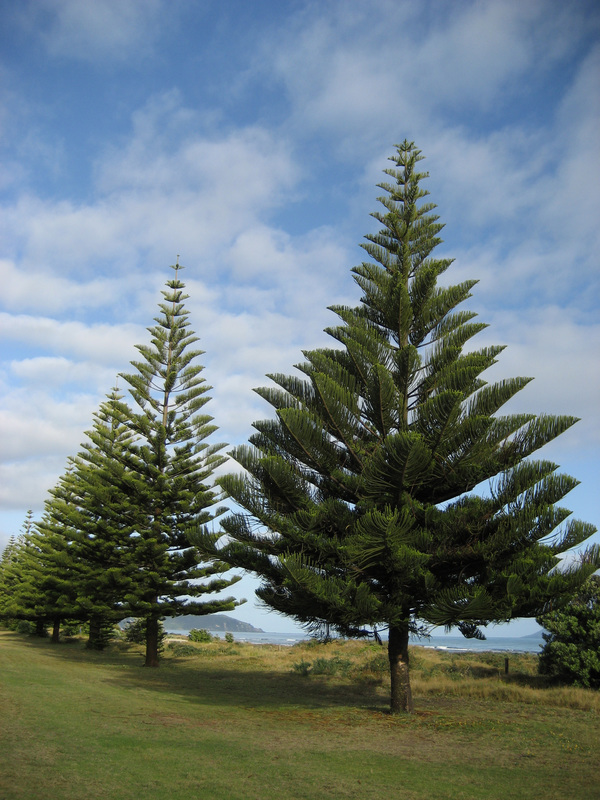|
As with any other tree that you plant in your yard, we suggest that you do your homework, and find out the growth habits, and what the tree will require as it begins to grow... RAPIDLY. The average maximum height of Norfolk Island pine trees in Florida, is 80 feet, though they can easily grow taller, some even exceeding 100 feet. The reason for this is fairly simple. The average height of the rest of the canopy is 80 feet. When a tree extends above that range, the risk of being struck by lightning increases greatly. Things to Consider:
The Norfolk Island Pine tree is actually not a true pine tree. It is a member of the ancient, Araucariaceae family. The name Norfolk Island pine, indicates it is endemic to a small island in the Pacific ocean, between New Zealand and Australia, called Norfolk Island. These trees are commonly seen on rocky shores and are known to withstand strong winds severe weather. Often, trees with multiple trunks are selected for their symmetrical shape. While this is fine for smaller trees, it is recommended that a single trunk be selected to remain, and all others properly removed over time. Weak branch attachment is one of the leading causes of failure in Norfolk Island pines. Several counties in Florida, prohibit people from planting the Norfolk Island pine in the landscape. Though it is not an invasive species, it is often considered a hazardous tree due to it's fast growth, and weakened branch attachments. These trees are also very susceptible to lightning strikes as they mature, because they quickly become the tallest point in the landscape. If you have a tree that has been struck by lightning recently, act quickly. It is imperative that sick, dying, or dead trees be removed in a timely manner, as they do not tend to stand long.
If you have any other questions regarding the Norfolk Island pine, please let us know. And as always, we look forward to the opportunity to care for your trees. Call or click, and we will schedule a free estimate with our Certified Arborist.
0 Comments
With the rapid decline of Citrus trees in and around Pinellas County, and their uncertain future looking ahead, I rarely recommend that anyone attempt to plant them. They just aren't doing well in Florida anymore. Because of this, I am frequently asked what type of fruit tree should be planted instead of Citrus? As I run down the list of fruit trees that thrive in Florida, the one that usually stands out the most, is the Mango tree.
The Mango is universally considered as one of the finest fruits, and one of the most important fruit crops in the tropics, and subtropics. While Pinellas County is at the northern edge of the Mango tree's hardiness zone, the tree can still thrive here. Things to consider:
The Mango tree does not tolerate cold temperatures. Young trees can die if the temperature drops below 30 degrees for only a few hours. This means that they will need some type of protection from the cold, until they begin to mature, and even then, some leaf damage, and twig dieback is to be expected when the temperatures drop below 40 degrees. If temperatures drop below 25 degrees, for as little as a few hours, mature trees can die. One common complaint that I hear from customers who already have Mango trees is, 'This thing produces more Mangoes than I would eat in a lifetime, in just one season.' The canopy of a healthy, mature Mango tree can spread as far as 100' and can reach a height of 30' and can produce up to 6 bushels of Mangoes, in one season. As with any fruit bearing tree, there is a very good chance that opportunistic pests will begin to take a liking to your Mango tree. Mangos are a main staple in the diet of fruit rats, and even squirrels have been known to take bites out of Mangoes while they hang in the tree. Mango trees are susceptible to many different types of insect pests, but seldom does this limit fruit production. The two main causes for decline and death in Mango trees are, Anthracnose, and Powdery Mildew, both fungal pathogens. Before You Plant
Once established, Mango trees require very little supplemental watering, usually only during periods of drought. Do not apply supplemental water to leaves, or blooms. Mulch around the base of the tree is suggested, but only a thin layer. Fertilization is recommended in order to produce a healthy fruit crop. As with any tree, the best mulch to use, is the leaves that fall from the tree, as they break down and become fertilizer for the tree. If you have more questions, or would like to learn more about this or any other tree, please don't hesitate to contact us. We would be happy to schedule an appointment. |
Matthew NealAn ISA Certified Arborist with 11 years of experience. Expert in problem diagnosis and treatment. Archives
March 2016
Categories |




 RSS Feed
RSS Feed
